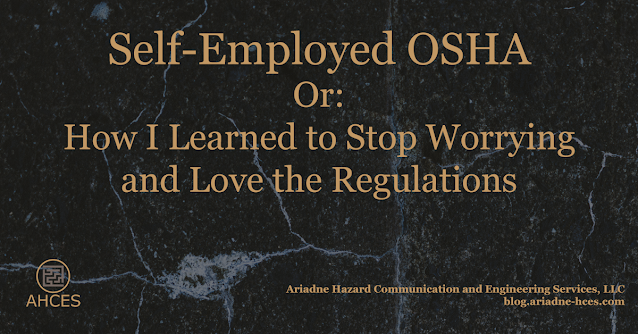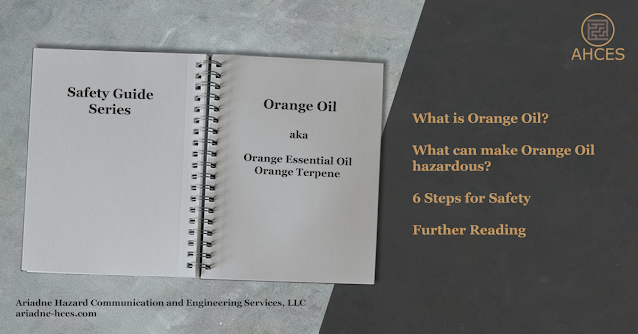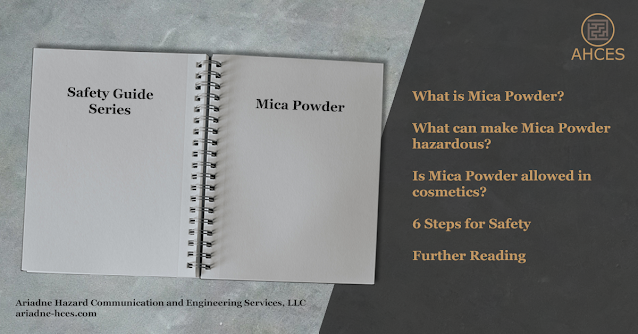Does OSHA Cover Self-Employed People?
Does OSHA cover self-employed people? In short, no.
OSHA has addressed this in a Standard Interpretation "OSHA has no authority to issue citations to a self-employed ... worker." Self-employment is also addressed within some of the OSHA regulations pertaining to incident reporting under 29 CFR 1904.31(b)(1) "self-employed individuals are not covered by the OSH Act."
However, if you are self-employed, you should still care about OSHA.
Self-Employed OSHA
Or: How I Learned to Stop Worrying and Love the Regulations
The Basics
There are some core definitions that are key to understanding how OSHA regulations are implemented.
Employer means a person engaged in a business affecting commerce who has employees, but does not include the United States or any State or political subdivision of a State. 29 CFR 1910.2(c)
Employee means an employee of an employer who is employed in a business of his employer which affects commerce. 29 CFR 1910.2(d)
OSHA regulations are generally written as instructions for what an Employer needs to do to keep an Employee safe. This ranges from safety training programs to equipment like a fall protection harness to warning signs like a hazardous chemical label. Employers have most of the responsibility under OSHA, both for creating and enforcing a safe work environment.
Employees are in turn required to follow the safety procedures and OSHA requirements.
This is why self-employed people are not covered by OSHA. As a self-employed person is both the employer and the employee, OSHA cannot penalize you for failing to protect yourself from yourself. Solo-practicing independent contractors, with no employees or sub-contractors, are the primary self-employed persons who are exempt from OSHA regulations.
Best Practices
Even though a self-employed person cannot be cited or
fined by OSHA, that does not mean the OSHA regulations should be ignored. OSHA
regulations are designed for safety. Being self-employed does not make a person
immune to injuries from a fall, an electrical shock, or being poisoned.
OSHA regulations can be used by self-employed persons as guidelines for best practices in what tasks they are performing. There is a wide range of OSHA eTools as well as the ChapterXVII Regulations to be used as references.
The extent of the OSHA regulations can be overwhelming. Most are, however, specific to certain fields of work. A handcrafted soap maker working with lye water probably does not need to worry about construction scaffolding regulations or crane safety, but they do need to understand hazardous chemical safety. Be sure to focus on what you do.
Multi-Employer Workplaces
OSHA has a Multi-Employer Citation Policy which defines the roles and responsibilities of employers when
multiple employers are at the same work location. A common example is a construction
site with multiple specialty contractors, such as carpenters, electricians, and
plumbers.
A self-employed person violating OSHA regulations may put others at risk. The Standard Interpretation is clear in multi-employer workplaces when a self-employed contractor is involved, “OSHA ... requirements must be met by employers where employees are exposed to a hazard created by a self-employed worker.”
A responsible employer will not want to work with a self-employed person who does not follow OSHA regulations, as they may be held liable for not protecting their own employees from any hazards that arise. Following OSHA regulations is often a part of the contract signed between an employer and an independent contractor, even if the contractor is otherwise exempt from direct enforcement from OSHA.
From Self-Employed to Small Business
OSHA does apply to small businesses. A self-employed person
who expands their business by hiring part-time or full-time employees becomes an
employer under OSHA.
The responsibility for following OSHA in the case self-employed person hiring another self-employed person is not well defined. In the event there is a reportable incident, OSHA would likely have to assess the situation on a case-by-case basis. It is always better to follow OSHA regulations when there is any doubt.
Following OSHA regulations while self-employed makes transitioning to being a small business employer easier by already having the basis for compliance in place.
What to Focus On
Most Frequent Citations
OSHA issues an annual Top 10 Most Frequently Cited Standards.
For 2022, the Top 10 are:
- Fall Protection
- Hazard Communication Standard (Safety Data Sheets, Chemical Labels)
- Respiratory Protection
- Ladders
- Scaffolding
- Control of Hazardous Energy (Lockout/Tagout)
- Powered Industrial Trucks (Forklifts, etc.)
- Fall Protection Training
- Eye and Face Protection
- Machinery and Machine Guarding
The topics in the Top 10 have not changed between 2021 and 2022. Fall Protection has held the top place for twelve years in a row.
When trying to figure out what OSHA regulations would apply to you, start by asking yourself if any of the frequent citations apply to what you do.
Industry Specific
OSHA has a Search Tool for
seeing what the most common citations are per Industry.
By using the North American Industry Classification System (NAICS) Number for your industry (such as 23813 for Framing Contractors or 56172 for Janitorial Services), you can see what citations were issued for the previous year for other businesses in your industry. This allows you to see what common dangers your industry faces.
Cabinet Making Example
Let's say you are a cabinet maker. You need to cut wood to the correct size, sand the wood, assemble the pieces, finish with a nice coat of lacquer, and then install the finished cabinets. What are the potentially hazardous activities involved in each step?
- Cutting the Wood
- Does the saw have a safety guard?
- Are you wearing gloves and safety glasses?
- Do you have respiratory protection from sawdust?
- Sanding the Wood
- Is the sawdust smaller than that made by cutting the wood? Do you need a different type of respirator?
- Is there a powder cord for the sander that could be a tripping hazard?
- Assembling the Cabinet
- If assembling with screws, are you wearing gloves and safety glasses when using the drill? Can any loose clothing or long hair get caught in the rotating drill?
- If assembling with glue, is the glue harmful to human health? Is it irritating to the skin or can it give off harmful vapors?
- Lacquering the Cabinet
- Have you read the safety data sheet for the lacquer? What does it say about any hazardous properties of the chemical?
- Are there harmful vapors that require respiratory protection? Do have the correct type of filters for a respirator for organic vapors?
- If it is flammable, are you storing it properly when not in use?
- Installing the Cabinet
- Are you on a ladder?
- If the cabinet or any of your tools fall, could they hurt you or someone else?
Conclusion
OSHA regulations are meant to keep people safe. Even if you don't have to follow them, it is a great idea to follow them anyway.
Working safely is a good habit to get into. Other employers will prefer working with someone who works safely. Future expansion will also be easier if you already have a solid grasp of the regulations you will be required to follow.
Original Posting Date: Feb. 08, 2023
Last Updated: Oct. 17, 2023






Comments
Post a Comment